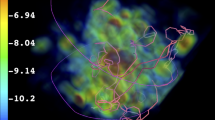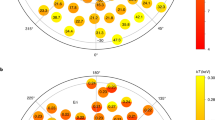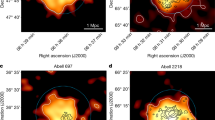Abstract
I SHOW here that the observational features of unidentified, high latitude, X-ray sources1 are consistent with the suggestion that they are a population of remote, optically undetectable, globular clusters. The principal objection to the hypothesis that the high latitude sources are members of any galactic population is their isotropy in galactic longitude. But if it is assumed that the most distant unidentified high latitude source radiates at 1038 erg s−1 (a typical value for a bright globular cluster X-ray source2,3) and that it is the faintest unidentified high latitude source, visible at 1–2 Uhuru counts s−1, its distance would be ∼ 200 kpc. Then, extrapolating to the brightest unidentified source at 7 counts s−1, we get a lower bound on the minimum distance to any objects of about 80 kpc, and the volume toward the galactic centre ,between −90° < lII < 90° in the ‘shell’ from 80 to 200 kpc, differs negligibly from the volume toward the anticentre, at 90° < lII < 270°. Although a specific radiation model is used in this case, the luminosities do not affect the basic result.
This is a preview of subscription content, access via your institution
Access options
Subscribe to this journal
Receive 51 print issues and online access
$199.00 per year
only $3.90 per issue
Buy this article
- Purchase on Springer Link
- Instant access to full article PDF
Prices may be subject to local taxes which are calculated during checkout
Similar content being viewed by others
References
Matilsky, T., et al., Astrophys. J., 181, 753 (1973).
Clark, G., Astrophys. J. Lett. (in the press).
Canizares, C., and Neighbors, J. E., Astrophys. J. Lett. (in the press).
Arp, H. C., in Galactic Structure (edit. by Blaauw, A., and Schmidt, M.), 401–434 (Chicago University Press, Chicago, 1965).
Lohmann, W., Z. Astrophys., 30, 234 (1952).
Abell, G. O., Publs. Astr. Soc. Pac., 67, 258 (1955).
Burbidge, E. M., and Sandage, A., Astrophys. J., 127, 527 (1958).
Schmidt, M., Bull. Astr. Insts Neth., 13, 15 (1956).
Eggen, O. J., Astro. J., 65, 393 (1960).
Oort, J. H., in Galactic Structure (edit. by Blaauw, A., and Schmidt, M.) 455–511 (Chicago University Press, Chicago, 1965).
Author information
Authors and Affiliations
Rights and permissions
About this article
Cite this article
MATILSKY, T. Galactic superhaloes, globular clusters and high latitude X-ray sources. Nature 257, 660–661 (1975). https://doi.org/10.1038/257660a0
Received:
Accepted:
Issue Date:
DOI: https://doi.org/10.1038/257660a0
Comments
By submitting a comment you agree to abide by our Terms and Community Guidelines. If you find something abusive or that does not comply with our terms or guidelines please flag it as inappropriate.



